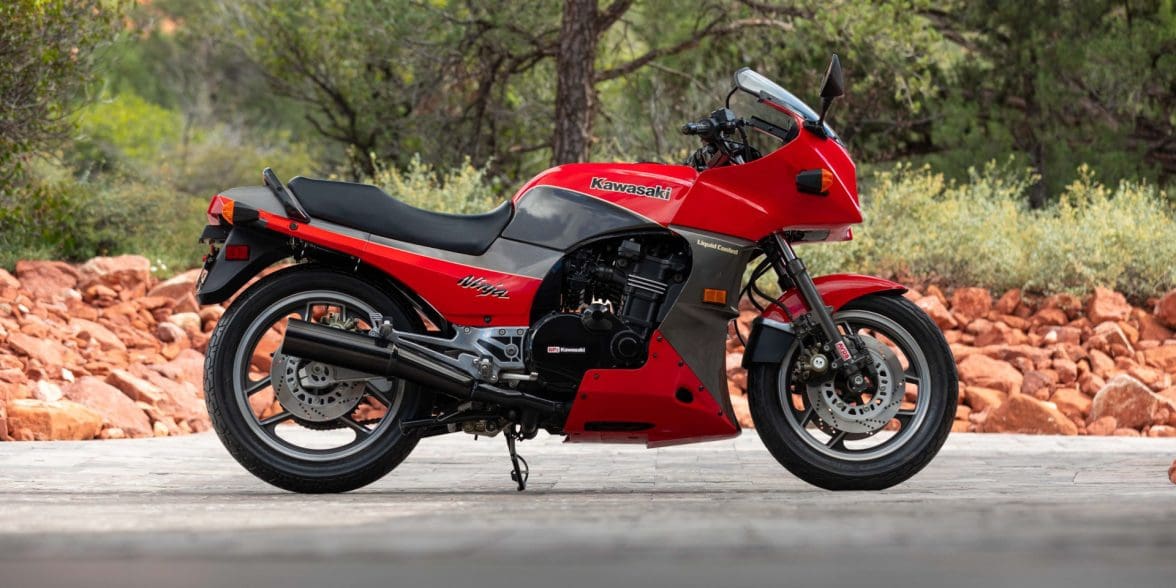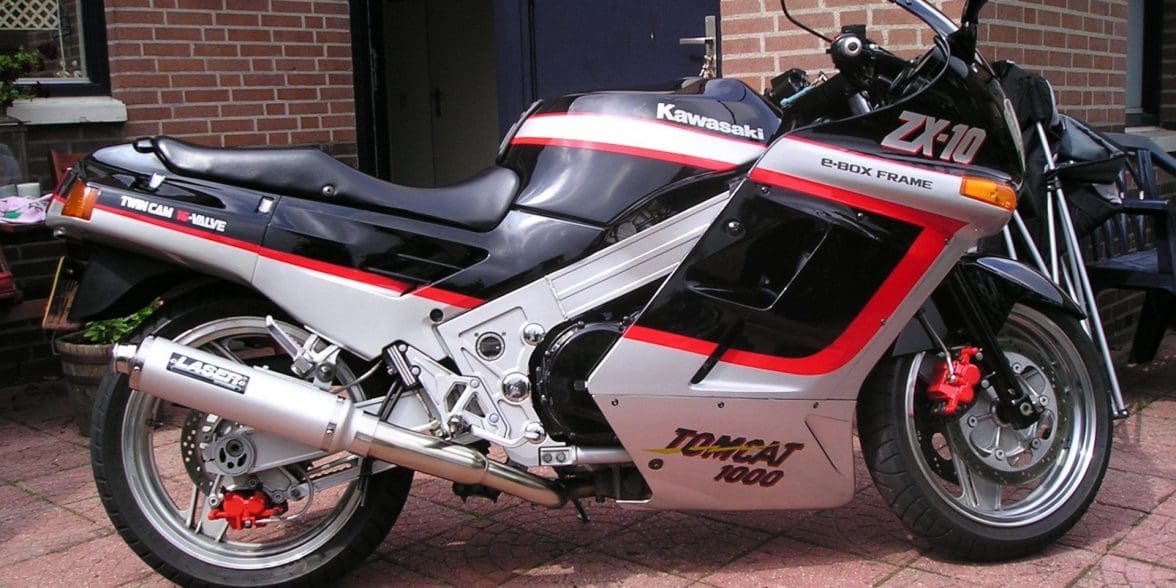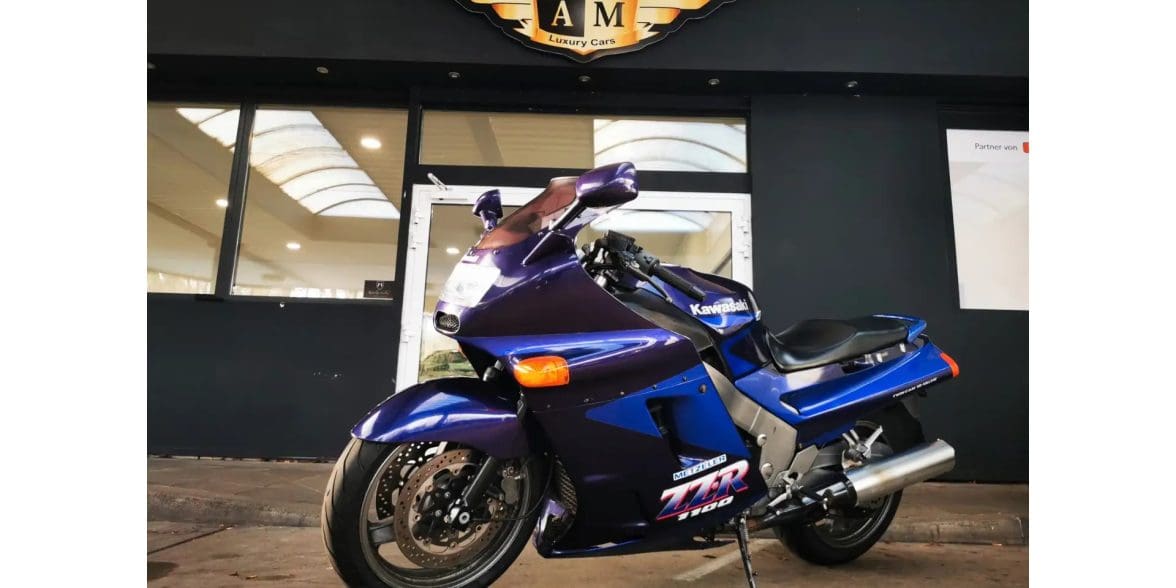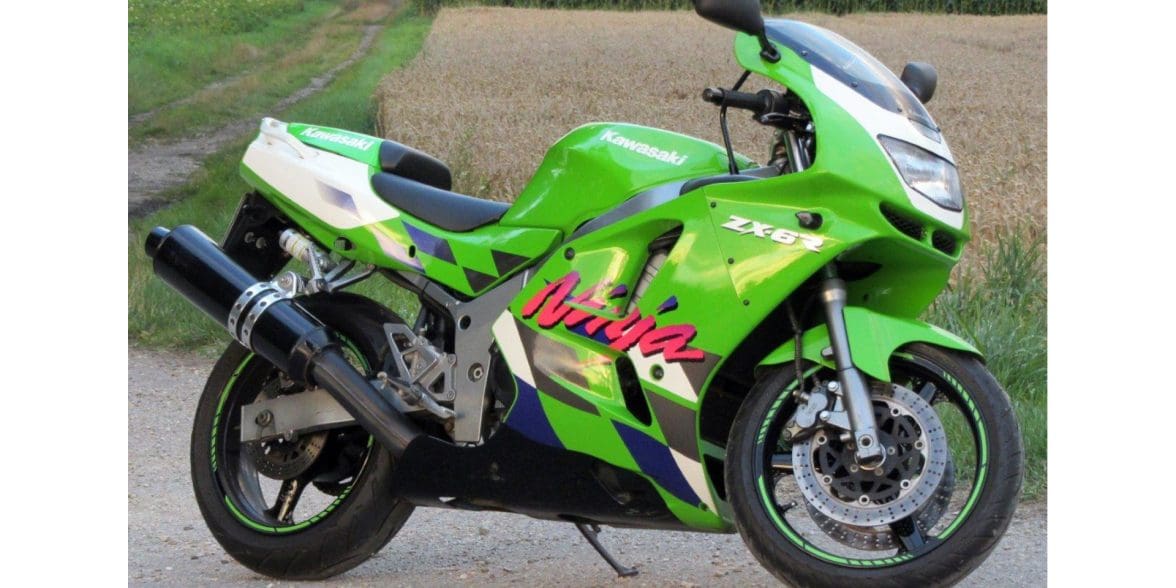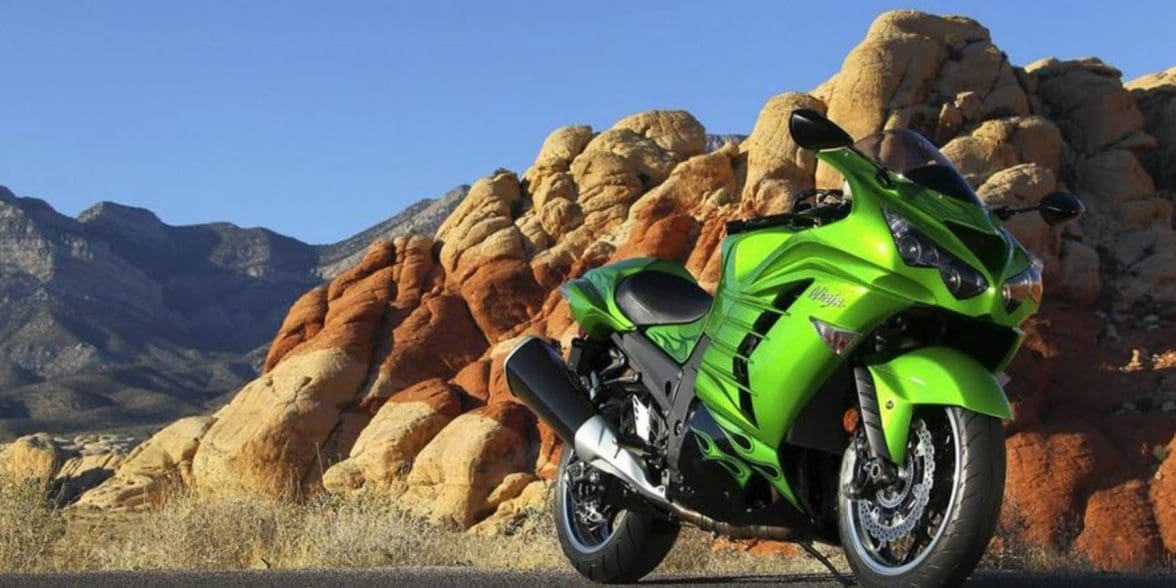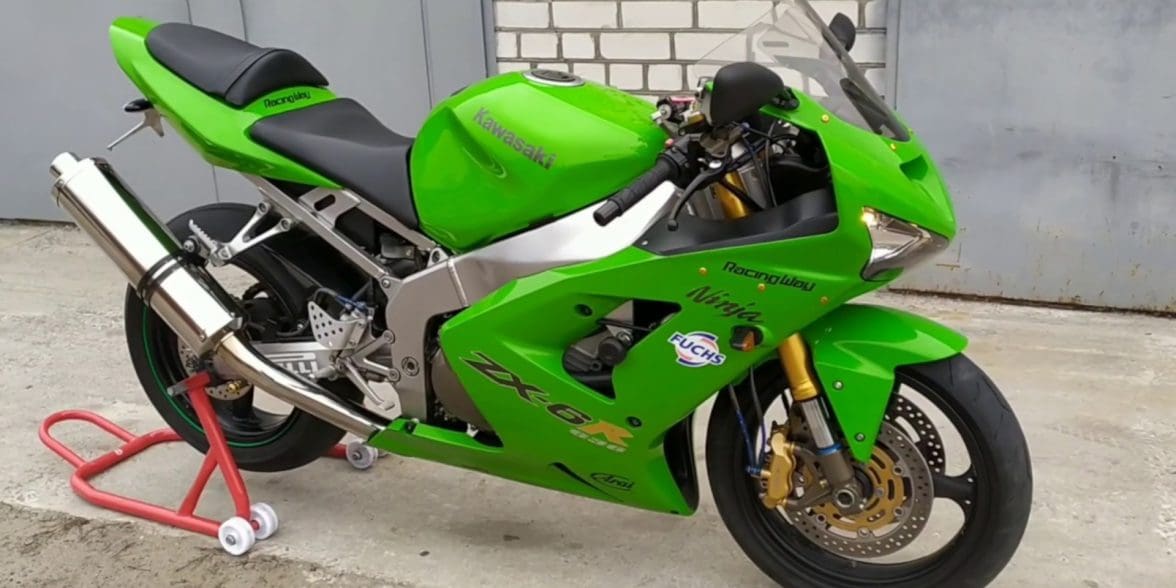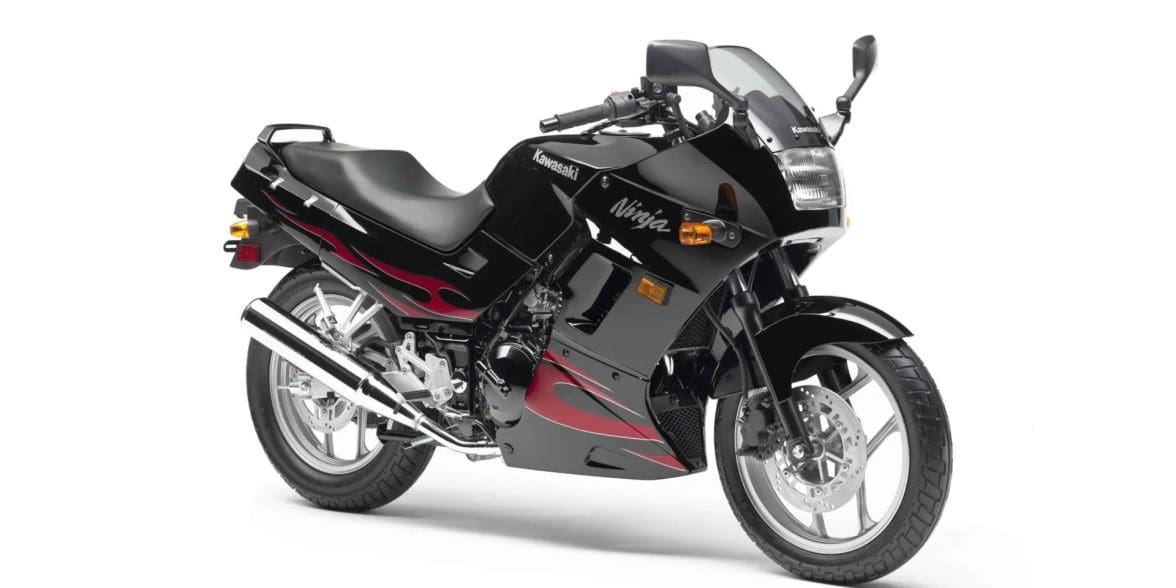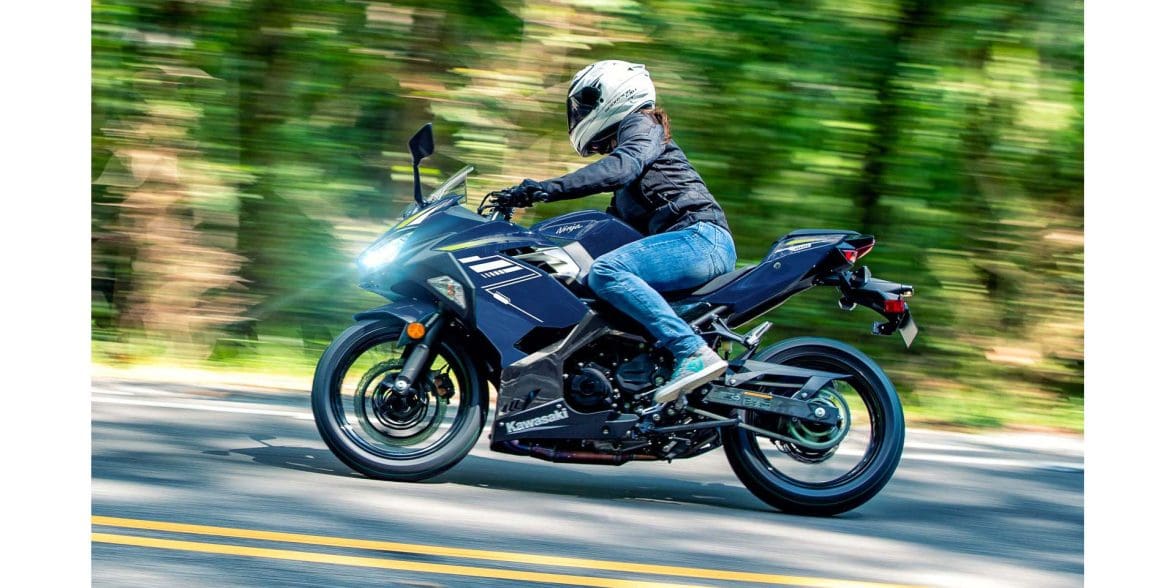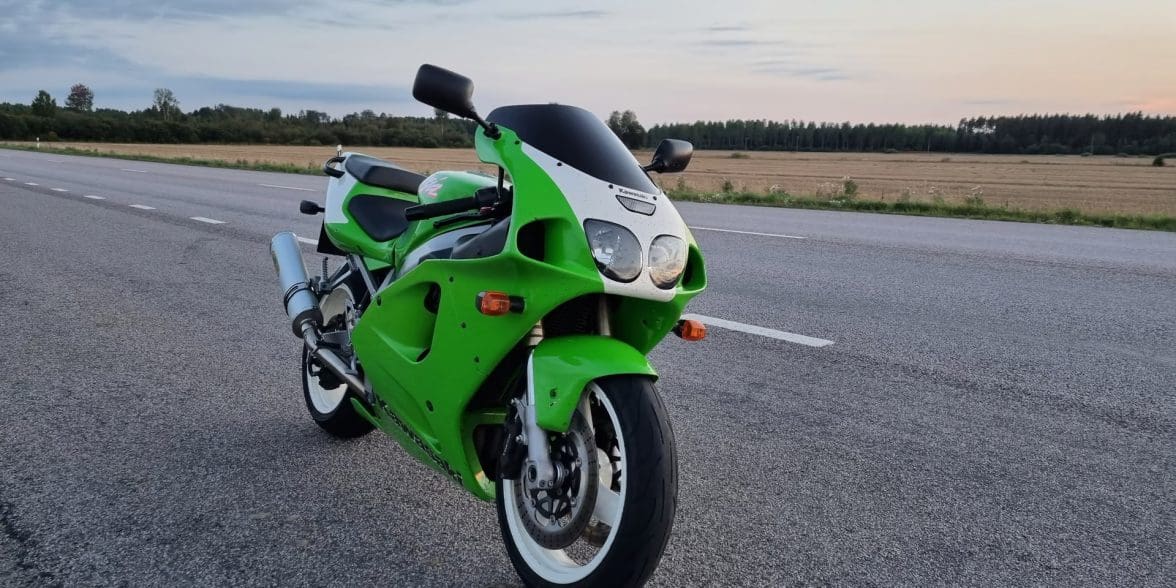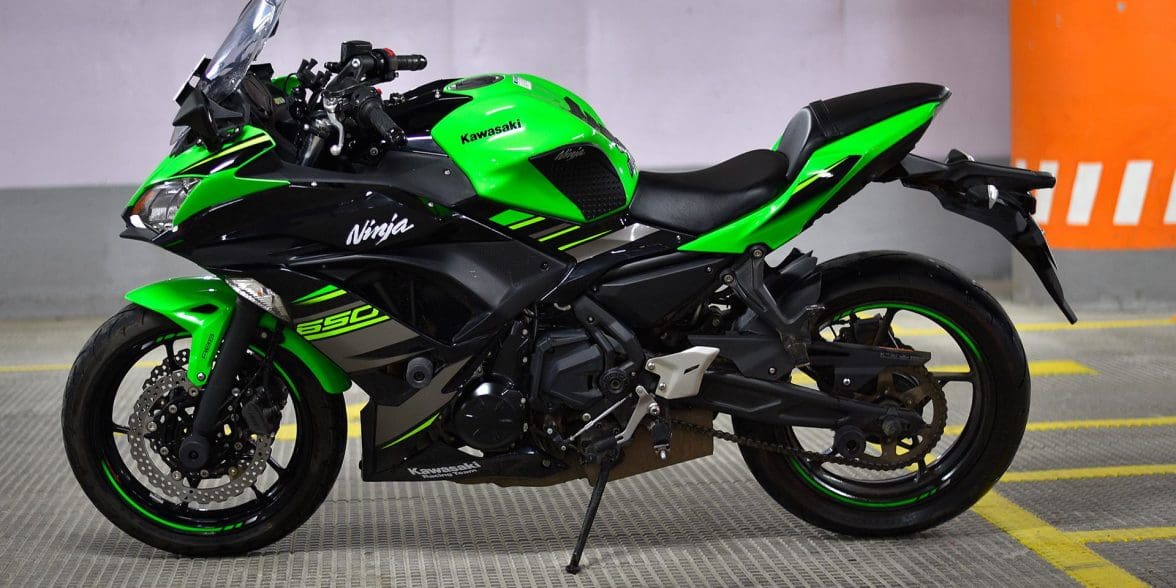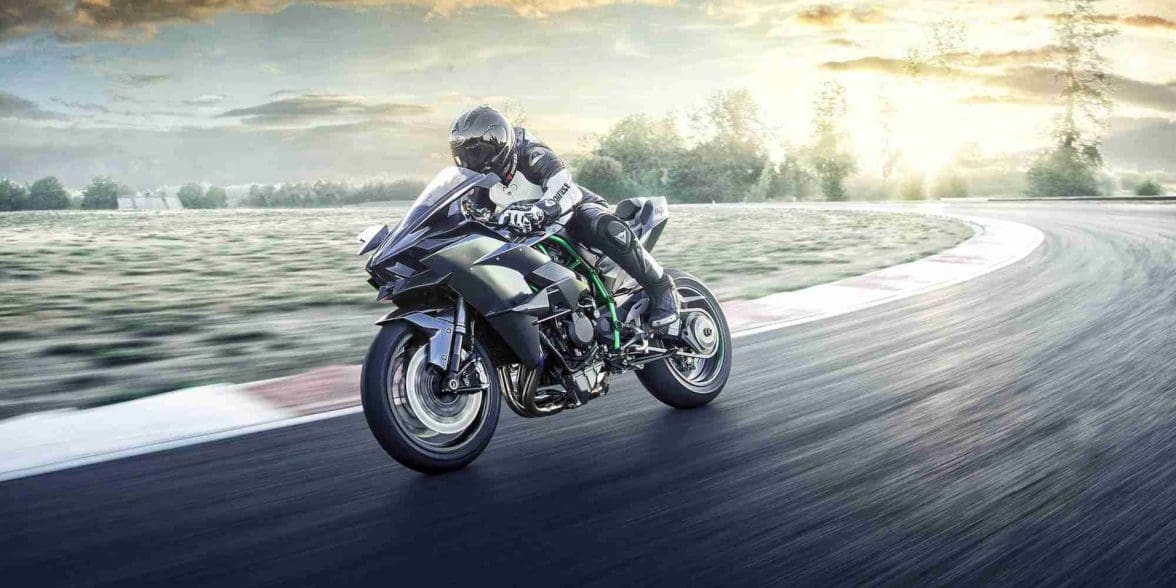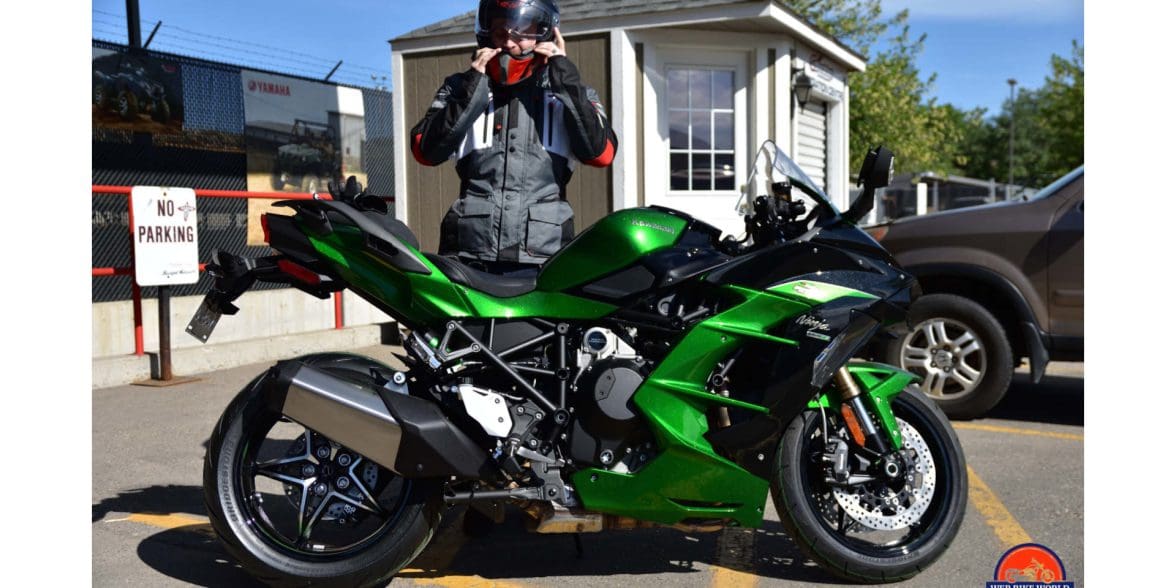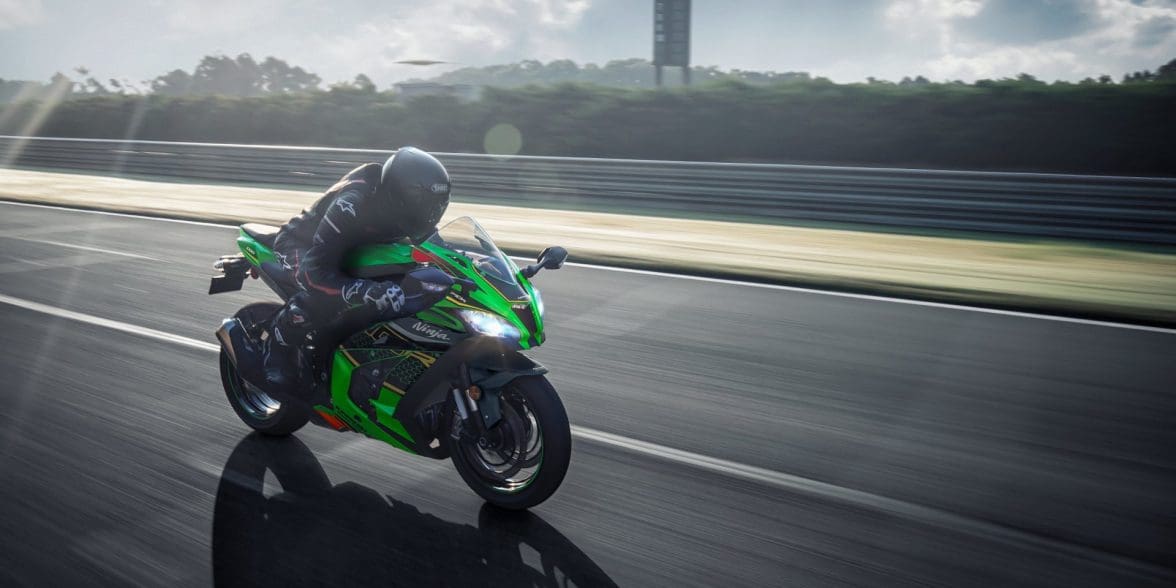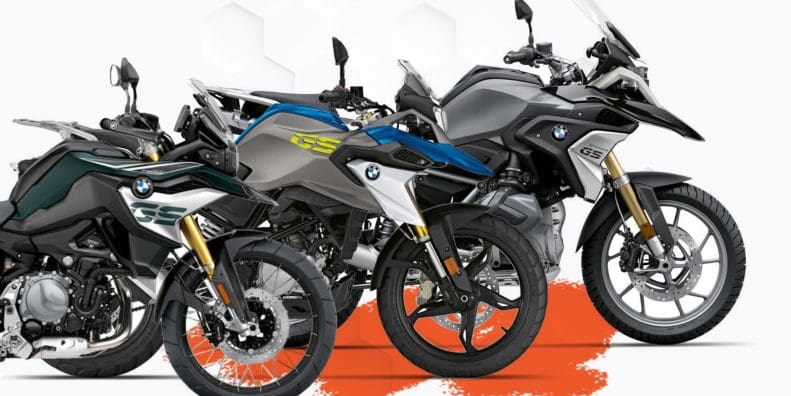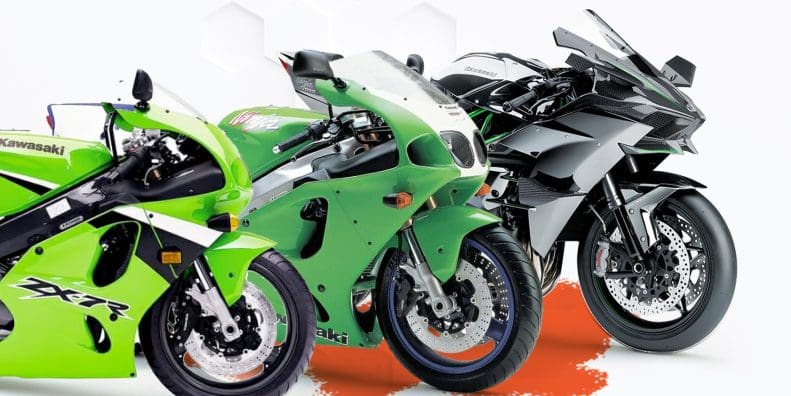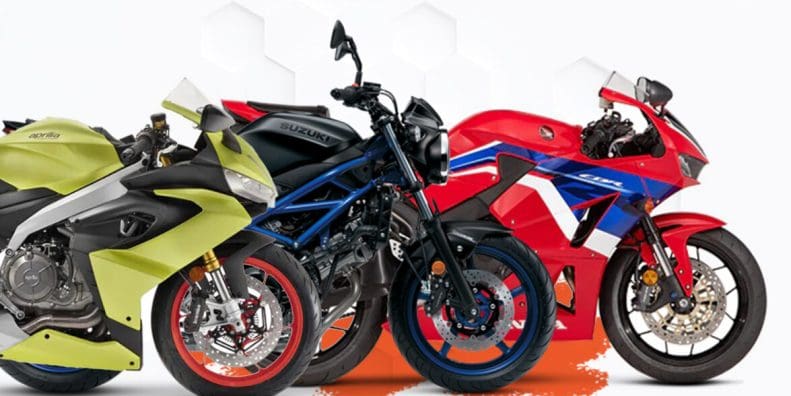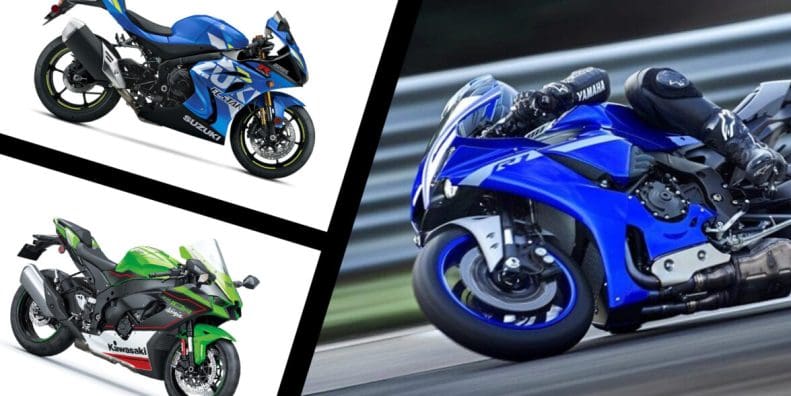The Best Kawasaki Ninjas Ever Made [2024 Edition[
Updated October 10, 2023 by Simon Bertram
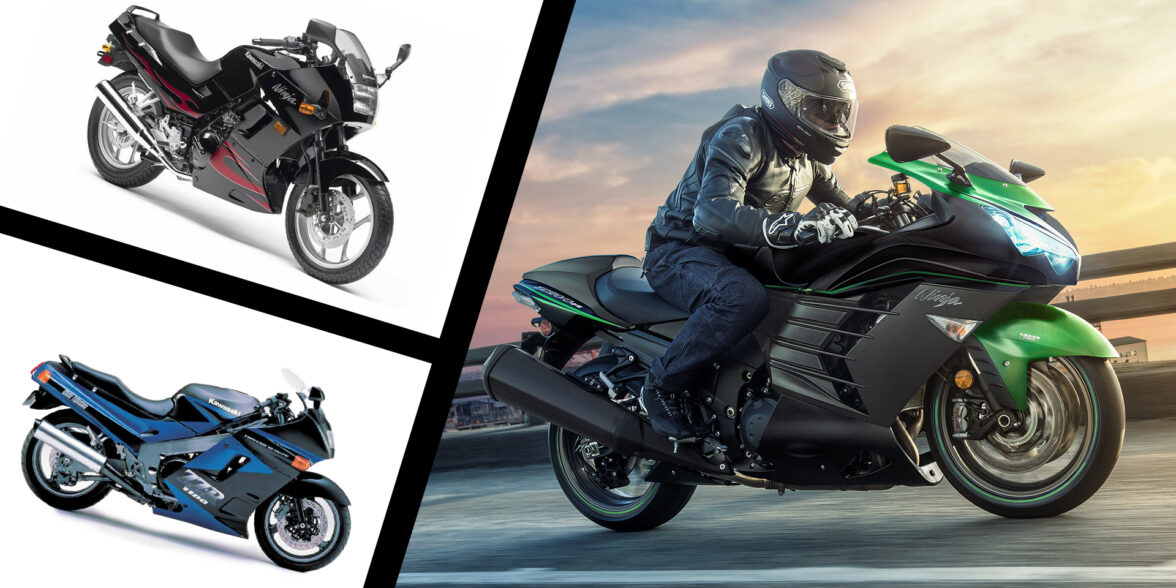
A Legendary Line Of Sport Bikes That Have No Equal
Article Quick Nav
These are some of the best Kawasaki Ninja's ever made:
As one of the Big Four Japanese manufacturers, Kawasaki has had a storied history in the world of motorcycling. From their classic UJM W1 to their nearly indestructible KL series of dirt and off-road bikes, they have always been there to ruffle the feathers of the other three of the Big Four and always in more ways than one.
Honda, it can be argued, was the company that started the sportbike and supersport style of motorcycles in the late 1970s. However, Yamaha, Suzuki, and of course Kawasaki threw their hats in the ring as well, building on the growing interest worldwide in performance machines. However, it was Kawasaki that landed the heaviest punch in the first round with the Ninja brand and name, and ever since, they have always been the performance-per-dollar leader in the segment.
Keep in mind, however, that there have been so many Ninja's made that we can't possibly cover every single one of them. We tried our best to keep the list to the mainstream bikes, the ones that really made a difference, and as such we did have to skip some niche favorites like the ZX-9R and the ZX7-RR. If we did a full list, this list would be a book instead!
So, in no particular order, here are some the best Kawasaki Ninja’s ever made, from 1984 to today.
About Our Selections
These selections only had one major criteria, in that they were Kawasaki Ninja motorcycles. The attempt was made to keep it to road legal bikes only as well.
1984 to 1996 Ninja GPZ900R
Do we really need to explain? The first bike to wear the Ninja badge, the bike that showed Suzuki what's up at the track, the bike that started it all
Why We Picked It:
No list about the best Ninjas ever made would be complete without the bike that launched the name. In development for six years behind closed doors and in the highest levels of secrecy, the GPZ900R exploded into the sportbike world in 1984 and was so good that it was in production for 12 years, until 1996.
It was the first Kawasaki sport bike to have an engine with 16 valves, which helped the 908cc inline-four to produce 115 HP. A technical masterpiece, the engine also allowed the GPZ900R to break through another world first, being the first supersport production motorcycle to pass 150 MPH. Oh, and being the hero bike in a small movie called “Top Gun” also helped raise its profile.
Specifications (1984):
Price: $3,999 in 1984 ($11,845 in 2023)
Engine: 908cc inline four
Power: 115 HP
Torque: 63 lbs-ft
Transmission: 6 Speed Manual
Curb Weight: 508 lbs
Strengths:
The first supersport to go beyond 150 MPH
Extremely popular and sold very well, very likely because of its short but significant appearance in Top Gun
Learn More:
1988 to 1990 Ninja ZX-10 Tomcat
The origin of the ZX naming, and what a bike to introduce it with!
Why We Picked It:
When the GPZ900R set and broke the record for the fastest supersport production bike, Kawasaki decided to maintain their record-breaking streak. In 1986, the Japanese brand released a follow-up machine, known as the GPZ1000RX. Building on the GPZ900R’s success, the new model soon claimed the fastest production motorcycle title. Though the newer model was intended to replace the GPZ900R, it didn’t. Instead, it hit the dealerships as a premium alternative to the already successful 900R.
In 1988, a differently designed 1,000cc bike replaced the 1000RX. For the first time, the famous ZX initials were used with the ZX-10. It brought forth quite a few technical firsts, such as the first aluminum perimeter frame; the first to use 36mm downdraft carburetors; and the first to break through 165 MPH. Production only lasted 2 years, until 1990, but the impact the model had on the sportbike world would reverberate through the 90s.
Specifications (1988):
Price: $5,999 in 1988 ($15,605 in 2023)
Engine: 997cc inline four
Power: 137 HP
Torque: 75.9 lbs-ft
Transmission: 6 Speed Manual
Curb Weight: 560 lbs
Strengths:
The first Ninja to use the ZX prefix to denote a supersport or superbike
The first Ninja to break through 165 MPH to a top speed of 168 MPH
Learn More:
1990 to 2002 Ninja ZX-11 (ZZ-R1100)
The bike that set the bar for the Power Wars of the 1990s
Why We Picked It:
The follow-up model and the “final version” of what the ZX-10 Tomcat was meant to be, the ZX-11 ZZ-R1000, apart from having a long and redundant name, was a long-standing stalwart of the sportbike world. Using much of the same frame and design of the ZX-10, the ZX-11 added two key features that made it a monster.
The first of these was improved aerodynamics, as engineers were understanding more and more how the air flowing over the bike could be used to both stabilize the machine and improve handling and cooling. The second feature that made it a dominant monster was that it was the first sports production motorcycle to employ a ram-air induction system.
With a specially designed intake that sat below the headlight, under a certain speed the engine took the air in normally. However, once moving at a good clip, the air started to compress as it passed through the specially shaped intakes and thus allowed the engine to produce 134.5 HP and 79 lb-ft of torque at 8,000 RPM. This allowed for the ZX-11 to blast through the previous record top speed and hit 176 MPH.
Specifications (1990):
Price: $7,599 in 1990 ($17,895 in 2023)
Engine: 1,052cc inline four
Power: 145 HP
Torque: 78.8 lbs-ft
Transmission: 6 Speed Manual
Curb Weight: 603 lbs
Strengths:
Introduced the ram-air induction system for motorcycles
Had one of the best designed and well engineered transmissions of its day, losing on 7.4% of power, meaning the bike was producing 134.5 HP at the rear wheel!
At the top of 6th gear, bouncing off the redline, the bike was capable of 176 MPH
Learn More:
1995 to 2002 Ninja ZX-6R
The origin story of one of Kawasaki's most popular motorcycles of all time
Why We Picked It:
With Kawasaki seemingly the dominant force in the large displacement section of the sportbike segment, the other three manufacturers from Japan brought the fight to the now-legendary 600cc supersport class. Of course, Kawasaki had a 600cc motorcycle already in the ZX-6E, but it was designed as a much gentler sport touring motorcycle.
As such, Kawasaki responded to the announced plans of a new “junior” supersport segment by developing the 1995 ZX-6R. The original model had a smaller version of the ram-air intake that the ZX-11 had launched, but fed that air into a high-RPM inline-four that produced almost dead on 100 HP. A couple of evolutions in the late 90s with the G model (bumping power to 108 HP) and J model (which boosted the compression ratio in the engine to better use the compressed rammed air, bringing the power to 112 HP) brought Kawasaki more inline with the competition.
However, to beat them, Kawasaki would have to create one of the most respected and feared 600cc supersport machines ever made, which we will discuss a little later in the list.
Specifications (1996):
Price: $7,899 in 1996 ($15,495 in 2023)
Engine: 599cc inline four
Power: 100 HP
Torque: ~49 lbs-ft
Transmission: 6 Speed Manual
Curb Weight: 446 lbs
Strengths:
Kawasaki's first entry into the 600cc class of supersports for the road
Used the ram air induction system originally deployed on the ZX-11
Later versions had 108 HP, then 112 HP, before the model was overhauled in 2003
Learn More:
2006 to Present Ninja ZX-14R
Is it a superbike? Is it a sport tourer? Maybe it's both: A super sport tourer
Why We Picked It:
In the late 1990s, there was an unofficial but very popular competition going on between the Big Four. Alternatively called either the “Power War” or the “Displacement War,” both titles describe the surge of bigger, more powerful, faster motorcycles, at times to the point of being ridiculous. Suzuki ended the war with the 1999 Hayabusa or GSX1300R by its model code... or so they thought.
Kawasaki took their time to respond, but in 2005 the brand pulled the covers off of the year 2006 Ninja ZX-14 at the Tokyo Motor Show. It boasted a larger engine than the Hayabusa, faster acceleration, and it did not look like someone had sneezed and made a motorcycle. It was angular yet flowing, aggressive in all of the right ways, and could beat any competition in a game of top trumps.
What took the ZX-14 from being a great Ninja to one of the best of all time, however, was its ability to obliterate a drag strip, even in stock, showroom trim. 0 to 60 MPH was achieved in just about 2.5 seconds. Though the top speed was limited to 186 MPH, with an ECU flash that restriction could easily be lifted. In stock trim, it could run the quarter-mile in just about 9.7 seconds.
And things only got better in 2011, when Kawasaki released the model refresh, upping the engine size, horsepower, and acceleration. They also appended the R to the end of the name, as it had also been trialed on the track, and had proven to be a capable–if somewhat heavy–track-day bike that could carve corners with the best of them. To this day, it is still the favorite for riders that like to consider the right wrist as a hyperspace lever from Star Wars, because everything goes from visible to a starry blur faster than the blink of an eye.
Specifications (2023):
Price: $16,599
Engine: 1,441cc inline four
Power: 208 HP
Torque: 113 lbs-ft
Transmission: 6 Speed Manual
Curb Weight: 593 lbs
Strengths:
Next to the H2R, one of the fastest and most powerful bikes that Kawasaki has ever made
Even in stock form, it will do a quarter mile in under 10 seconds, and will hit 60 MPH from a dead stop in 2.5 seconds
Was originally made as a response to the Suzuki Hayabusa, but has evolved into its own superbike from there
Is comfortable like a sport tourer, fast and precise like a superbike, and has a reputation for covering long distances at some speed... perhaps the world's first super sport tourer?
Learn More:
2003 to Present Ninja ZX-6R 636
A "600cc" supersport that has defined the segment for 20 years
Why We Picked It:
With the Honda CBR600F4i, the Yamaha YZF-R6, and the Suzuki GSX-R600 all breathing down its neck, Kawasaki pulled one of the most famous “fast ones” in motorcycle history by announcing a revamp of the ZX-6R for the 2003 model year, in the process creating that highly respected and feared bike we mentioned earlier. They announced a whole slew of technical innovations, new brakes, newly inverted front forks, the move from carburetors to fuel injection, and an all-digital dash. What they tried to sneak in was that the engine was also bumped from 599cc to 636cc.
Kawasaki argued that the displacement bump was to make room for the injector heads, but it was a thinly veiled white lie that allowed them to boost power, response, and speed. This resulted in Kawasaki winning many of the magazine and TV show reviews of acceleration, handling, engine smoothness, the works. Honda, Yamaha, and Suzuki cried foul as Kawasaki had upset the “purity” of the 600cc class, yet Kawasaki simply put their fingers in their ears, hummed very loudly, and pointed at the “racing” version of the bike, the ZX-6RR, that still displaced 599cc’s.
The other manufacturers grumbled some more, but the 636 was still classified as a 600cc supersport, and has defined the 600cc class for nearly two decades by now. There have been some attempts to rival it, but every time a bike has come along that seems to have a chance, Kawasaki just add a new feature or up the power a little bit and stay on top.
Specifications (2023):
Price: $10,699+
Engine: 636cc inline four
Power: 127 HP
Torque: 52 lbs-ft
Transmission: 6 Speed Manual
Curb Weight: 430 lbs
Strengths:
The supersport that has defined what a supersport should be and what it can do for just about two decades now
Highly respected and even slightly feared by other manufacturers, as no matter what they bring to the road, the ZX-6R 636 will have an answer for it by the next model year
Is one of the two "halo bikes" of Kawasaki, the other being the ZX-10R, that shows off their rider aids and rider connectivity suites, so it comes with pretty much everything you could ever think of wanting on a supersport
Learn More:
1988 to 2007 Ninja 250R
So good that it lasted almost 20 years before a major upgrade took away a little bit of the magic
Why We Picked It:
Known throughout its model life as the Ninja 250R, the EX250, or the GPX250R, this humble little parallel-twin engine motorcycle had a bit of a rough start to life. Originally released in Japan in 1983, and the rest of the world in 1986, the Ninja 250R engine suffered from bad compression, and the carburetors feeding it were too large. This made the bike great on fuel, but very slow to rev and accelerate.
In 1988, however, the model revamp that everyone wanted finally arrived. While the interior bore and stroke of the parallel-twin remained unchanged, the carburetors were made smaller, the compression was raised significantly, and the ignition timing was advanced to match these two changes. All of a sudden, a laborious, slow-revving engine became a screaming, 14,000 RPM powerhouse.
Changes to the suspension and the addition of three teeth to the rear sprocket also gave the agile little street weapon some serious acceleration. It also impressed in the handling department too, with the inherent balance of the parallel-twin slung way down low in the body allowing ridiculous lean angles in canyon carving outings.
The Ninja 250R was considered so good in its 1988 layout and specification that it only received a couple of minor cosmetic refreshes throughout its lifetime, lasting all the way up to 2007, when the last great carbureted small-displacement Ninja was silently shuffled off the order sheet and replaced with the fuel-injected Ninja 250R and its bigger brother, the Ninja 300. In changing the fueling style, a little bit of the rawness of the carbureted engine, the way it had a low whine of induction noise to match its screaming exhaust note, was lost, and it robbed the bike of a little magic. This is why we stopped the count at 2007, and not 2012 when the 250R ceased production.
Specifications (2006):
Price: $2,999 in 2006 ($4,578 in 2023)
Engine: 248cc parallel twin
Power: 45 HP
Torque: 17.7 lbs-ft
Transmission: 6 Speed Manual
Curb Weight: 355 lbs
Strengths:
A generation of the 250R so good that it remained relatively unchanged for two decades, only really getting small evolutionary bumps in power as engine technology advanced
Was one of the last Kawasaki's to change from carburetors to fuel injection, but in this case, the change took away a little bit of the magic of the bike
The Ninja 250R is still produced today, but only for very select markets in Asia
Learn More:
2018 to Present Ninja 400
One of newest, and best, introductions to sport bikes for new riders
Why We Picked It:
Thanks in part to Kawasaki’s dominance in World Superbike Racing, as well as being the best price-to-performance manufacturer from Japan, there has always been a market for a “cheap bike” that can do everything you need it to do, a few things you didn’t know it could do, and that was generally easy to operate and maintain. Starting with the Ninja 300 throughout most of the 2010s, 2018’s Ninja 400 is exactly that bike.
It is not designed to be the fastest, the first, or even be shown a track, although it is perfectly capable on one. What the Ninja 400 does is give new and experienced riders alike a motorcycle that follows the ideals of the original UJM bikes from the 1970s. This is, namely, being a motorcycle that is easy to ride, comfortable for long periods (or at least longer than a supersport), with intuitive controls, a more standard riding position, and easy to maintain with accessible parts.
While there are other bikes out there that fill in the same needs, none do it quite as inexpensively as Kawasaki. This is not to say that the bike, or its manufacture, is “cheap” by any means, as the Ninja 400 and its predecessors have stood up to the test of time and miles with very few breakdowns entirely caused by wear. It has become a bit of a trope, however true or false, that if you have a lower displacement Kawasaki, you’ll either sell it or crash it before it breaks on you.
Specifications (2023):
Price: $5,299
Engine: 399cc parallel twin
Power: 44.8 HP
Torque: 27 lbs-ft
Transmission: 6 Speed Manual
Curb Weight: 366 lbs
Strengths:
The evolution from the 250R to the 300 and now to the 400 has kept a beginner bike available for new riders from Kawasaki for just under 4 decades
Is a very capable commuter, canyon carver, and is comfortable to a fault.
Upholds the original Universal Japanese Motorcycle creed: Easy to ride, comfortable, intuitive, easy to maintain
Learn More:
1996 to 2003 Ninja ZX-7R
A race bike for the road, little changed from competition to commute, making it one of the best supersports of all time
Why We Picked It:
While the ZX-7R badge emerged in 1989, it wasn't until the 1996 version that it fully hit its stride. This is because from 1989 to 1995, the ZX-7RR, the racing cousin of the road bike, was still undergoing development and while competitive, the results didn't start rolling in until 1992, with the first AMA Superbike Championship, and 1993, with the FIM World Endurance Motorcycle Title.
What makes the 1996 to 2003 version one of the best Ninja's of all time was that during this period, race parts were designed much like road parts, meaning that Kawasaki had the light go on over their head about bringing the two as close together as possible. The frame was a lightweight aluminum twin-spar design with computer aided design to optimize its strength. The swingarm was hollow and ultra-lightweight, like the racing bike. The front brakes were one step below powersports grade and were dual 320mm floating discs with six-piston Tokico racing calipers with street pads mounted in them.
But it was the engine that made it legendary. A 748cc inline four that absolutely howled up to 13,000 RPM, it was the exact same block, pistons, and head from the racing bike, chucking out a massive 110 HP and 56.4 lbs-ft of torque. It was immediately responsive, would go from idle to redline in about a quarter of a second if you revved it in neutral, and pulled like a runaway freight train in whatever gear you were in when you went wide-open with your wrist action.
The only difference, truly, between the race engine and the road engine is that the racing one has 41mm flat-slide carburetors instead of the 38mm ones on the road bike. That's honestly about it, making the ZX-7R one of those few race bikes for the road that honestly was a race bike... for the road.
Specifications (1996):
Price: $9,399 in 1996 ($18,440 in 2023)
Engine: 748cc inline four
Power: 110 HP
Torque: 56.4 lbs-ft
Transmission: 6 Speed Manual
Curb Weight: 500 lbs
Strengths:
Carried the same basic engine that the ZX-7RR racing bike carried, with slightly smaller carburetors, a different engine map, and different exhausts
Had the same frame and dynamics as the race bike, so it accelerated like it had been shot, was immensely agile, and would pull hard no matter where in the rev range and in any gear
Was one of the last truly race-bike-for-the-road type motorcycles in the 700cc superbike displacement category, which is seeing a "sort of" resurgence new with the arrival of the SuperTwin class of of 700cc parallel twins
The ZX-7RR race bike became a pretty dominant force in AMA Superbikes and the FIM World Endurance Motorcycle championships
Learn More:
2006 to Present Ninja 650
One of the best sport tourers the world has ever seen, and a mainstay of Kawasaki's lineup for nearly two decades now
Why We Picked It:
The Ninja 650R and 650 are here not because they are the latest and greatest in terms of sports technology, nor are they here because they were designed to smash the competition into itty bitty pieces. Why they are here, however, is because of the revolution that they helped to launch in the mid-2000s for people wanting to ride motorcycles.
For a while before 2006, if you wanted to learn to ride a motorcycle and have a good first bike, you either started out on a very low displacement machine, or you leaped headfirst into the 600cc and up supersport segment. There was no real middle ground, except with some European motorcycles that, because of tariffs at the time, cost an arm and a leg. Suzuki noticed it first around the turn of the millennium, with Kawasaki paying attention as well.
Those two manufacturers then brought out two of the most highly recommended beginner bikes: the SV650 and the Ninja 650. Finally, beginner riders had bikes that could carry them comfortably at a low cruise, and then with a twist of the wrist, turn into corner-carving sportbikes.
With a model revamp in 2012, the Ninja dropped the R from its name and is now legendary for being one of the best price-to-performance bikes a new rider can buy new, and keep using even after they’ve learned to ride. Even better, Kawasaki has somehow worked their magic through the years, always adding new things, new settings, new rider aids, smartphone connectivity, and the like, and the price still hasn't breached $9,000.
It truly is one of the best Ninja's ever made, and not because it's a howling, aggressive track bike. It's because the Ninja 650 lets more people feel welcome to the motorcycling community, and gives them a machine that while it will go fast and carve corners, won't bite their head clean off the first time they make a mistake, and we all know that we want more riders out there!
Specifications (2023):
Price: $7,999
Engine: 649cc parallel twin
Power: 68 HP
Torque: 47.2 lbs-ft
Transmission: 6 Speed Manual
Curb Weight: 419 lbs
Strengths:
A superb beginner bike that can turn into a life-long bike
Eases a rider into the idea of taking 400+ lbs through some canyon corners at mildly absurd lean angles, with more than enough forgiveness so that they don't get flung off in a highside
Has every available rider aid that Kawasaki can fit into it available, including stability control, traction control, smartphone connectivity, an assist and slipper clutch, and uses dual throttle valves to be both economical in riding, but immediate in response to power demands
One of the world's most popular sport touring motorcycles
Learn More:
2015 to Present Ninja H2R
Quite simply the world's fastest production motorcycle, despite being limited to the track only
Why We Picked It:
Always at the forefront of technology and development, there had been rumblings for years that Kawasaki had a supersport in development that would rattle the market. In 2015, Kawasaki unveiled the new Ninja H2R, and it not only rattled the supersport world, it bypasses superbikes and created an entirely new class of sportbikes now known as the "hypersport."
A track-only bike, it was a technical tour-de-force that made everyone, not just Kawasaki’s Japanese competitors, sit up and pay attention. Using the 998cc inline-four from a ZX-10R, engineers and designers then slapped on a high-speed supercharger that spins so fast that the tips of its impeller blades hit nearly 1.5 times the speed of sound. This compressed air then passes through an intercooler mounted below the radiator, then gets fed into the engine, producing a nominal 320 HP.
The H2R accelerates so hard, so brutally, and so in defiance of physics, that an entirely new set of stability, anti-wheelie, and traction control systems had to be developed. Even then, with the bike being made almost entirely out of carbon fiber, aerodynamic winglets had to be added to the front to keep the nose down at high speed.
For the moment, the H2R holds the world’s fastest production top speed record at dead on 250 MPH, and it is very unlikely that a petrol-powered regular production motorcycle will ever beat it.
Specifications (2023):
Price: $58,100
Engine: 998cc supercharged inline four
Power: 320 HP
Torque: 121 lbs-ft
Transmission: 6 Speed Manual
Curb Weight: 476 lbs
Strengths:
The single fastest production motorcycle ever made
Is unlike to be beat in a top speed race by anything petrol powered.
Some upcoming hypersport eMotos might stand a chance, but even the fastest of those currently on the market, the Lightning 218, will only hit 218 MPH
If it weren't for the winglets attached to the front cowling, the H2R would lift its nose from the aerodynamic pressure as it passed 220 MPH!
Learn More:
2016 to Present Ninja H2 SX SE & Other H2 Models
Track-ready supercharged power for the naked, superbike, and sport touring markets
Why We Picked It:
The 2015 Ninja H2R was always meant to be a limited series, a “this is what we can do” demonstration to the world that Kawasaki was at the top of their game. However, so much interest was raised from the release, as well as the customer demand for a road-going version, that the H2 program was morphed into Kawasaki’s top-tier lineup of motorcycles. There is the hypersport H2, the naked Z-H2, and then there is the most popular of the bunch, the sport-touring H2 SX.
Released in 2018, the H2 SX (H2 SX SE in some markets) was the ultimate expression of the sport-touring philosophy. Detuned from 320 HP to “only” 228 HP for the H2 and Z-H2, and 197 for the H2 SX SE, the inline-four 998cc engine nonetheless had huge power all over the place, so you could drop a gear and pass a truck on the highway with ease, or if you came to a hill, just roll on a bit more throttle and feel the surge as the supercharger whacks air into the engine.
While it is by no means cheap, the H2 SX is the most realistic of the bikes to come from the H2 project. Kawasaki traction control, anti-wheelie, 6 axis ICU, cornering ABS, dual-zone linked ABS, mounting points for panniers, raised clip-ons for a comfortable riding position… the H2 SX has it all and more. Even better, once it’s at a highway cruise, it has an intelligent eco mode that turns it from a monster with infinite power into a quiet, comfortable, albeit slightly big sport-tourer that sips gas.
It will still scare the bejesus out of you, however, if you aren't careful with your right wrist, so that H2 DNA is still there, just under the fairings, and that is what makes it a truly special Ninja, along with its two brothers.
Specifications (2023 H2 SX SE):
Price: $28,000
Engine: 998cc supercharged inline four
Power: 197 HP
Torque: 101 lbs-ft
Transmission: 6 Speed Manual
Curb Weight: 590 lbs
Strengths:
These models were created mostly because of interest and demand from customers, and Kawasaki realized they had a major market niche they could fill: factory forced-induction
Of the three models available, the H2 SX SE has seen the most success. This is usually attributed to being superbly comfortable while also packing one hell of a wallop when your right wrist cranks on the power.
Has pretty much every bell and whistle that Kawasaki could shoehorn into the bike, and then some!
Learn More:
2011 to Present Ninja ZX-10R
One of the world's most popular superbikes, if sales by volume and owner satisfaction are metrics to go by!
Why We Picked It:
To qualify this choice, there are three major areas of importance that need to be observed as to why the ZX-10R is quite possibly the greatest Ninja ever made.
The first area is sales volume. Compare how many ZX-10R’s have moved from a showroom to the R1, the CBR1000RR, or the GSX-R1000R. It’s shocking, but the ZX-10R has outsold them all, even if you combine all three together for a given year. This falls mostly upon the fact that Kawasaki is still the price-to-performance leader from the Big Four, as well as that Kawasaki was dominant in World SBK for damned near a decade from 2011 to 2021. Racing tech trickles down to street-based superbikes, and it shows with the tech that the ZX-10R packs.
The second area of importance that the ZX-10R fills is rideability. There is the thought amongst superbike riders that unless the bike is on a razor’s edge the whole time, it’s crap. Kawasaki thinks in the other direction. When it needs to be, it is a razor’s edge literbike, a canyon carving monster that screams over 13,000 RPM. But it also commutes relatively comfortably, still has plenty of power down low, and doesn’t send as much force through the rider’s wrists as other superbikes may. This is due to Kawasaki working hand in hand with Showa to make the front forks responsive and quick, but also soft enough to dampen out the bigger bumps.
The third area of importance is track performance. Any superbike rider will tell you that riding on the street and riding on the track are two entirely different things. While the Yamaha YZF-R1 may be considered the better all-around track bike and has tech trickle down from the M1R MotoGP bike, the ZX-10R is a direct brother to the World SBK ZX-10RR. You can quite literally take the street version ZX-10R, change out the brakes, the ECU, the shocks, and the wheels, and you have a bike that has won championships. So, of course, the ZX-10R is extremely handy around a track, and in the hands of a very good rider, can give even the vaunted R1 a run for its money.
In sum, it is basically the greatest street-legal superbike because it is the closest, by far, of any motorcycle to its top-class racing equivalent, is much less expensive than much of its competition, and is at the same time a capable, mostly comfortable commuter and a canyon-carving screamer.
Specifications (2023):
Price: $17,399
Engine: 998cc inline four
Power: 203 HP
Torque: 82.5 lbs-ft
Transmission: 6 Speed Manual
Curb Weight: 452 lbs
Strengths:
Consistently outsells all other superbikes from the Big Four Japanese, even if you combine all of their numbers together
Benefitted immensely from Kawasaki's championship run in World SBK during the 2010s, winning 6 riders trophies and 7 constructors trophies in the past 10 years alone
Very rideable, among the more comfortable superbikes out there. This is not to say it is anywhere near as comfortable as a sport tourer, but it is set up brilliantly for handling and dynamics in equal measure
In the hands of an expert, very little can challenge it on the track
Learn More:
Other Best Motorcycle Lists


